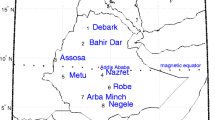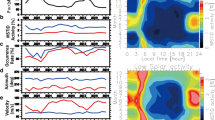Abstract
The regional ionospheric model is adopted to determine satellite-plus-receiver differential delay. The satellite-plus-receiver differential delay is estimated as constant values for each day. Dual-frequency GPS pseudo-ranges observables are used to compute vertical TEC (VTEC). All the monthly mean VTEC profiles are represented by graphs using GPS data of the Beijing IGS site between 2000 and 2004. The monthly averaged values and amplitudes of VTEC are also represented by graphs. The results indicate that the VTEC has seasonal dependency. The monthly averaged values and amplitudes of VTEC in 2000 are about 2 times larger than that in 2004. The maximum VTEC values are observed in March and April, while the minimum VTEC values are observed in December. The seasonal variations trend is found to be similar after polynomial fitting between 2000 and 2004.
Similar content being viewed by others
References
Camargo P O, Monico J F G, Ferreira L D D(2000) Application of ionospheric corrections in the equatorial region for L1 GPS users[J]. Earth Planets Space, 52:1 083–1 089
Chang Qing, Zhang Donghe, Xiao Zuo, et al.(2001)A method for estimating GPS instrumental biases and its application in TEC calculation[J]. Chinese Journal of Geophysics, 44(5): 596–601(in Chinese)
Liu Jingnan, Chen Junyong, Zhang Yanping, et al.(1999)Principle and method of WADGPS[M]. Beijing: Surveying and Mapping Publishing House (in Chinese)
Goldovsky N, Luria M(2004)Ionospheric delay contribution to the uncertainty of time and frequency measurements by one-way satellite time transfer method[J]. Measurement, 35: 353–362
Warnant R, Pottiaux E(2000)The increase of the ionospheric activity as measured by GPS[J]. Earth Planets Space, 52: 1 055–1 060
Xiao Zuo, Zhang Donghe(2000)An approach to study the day-to-day variations of ionospheric TEC directly by GPS time-delay signals[J]. Chinese Journal of Space Science, 20(2): 97–102(in Chinese)
Wild U(1994)Ionosphere and geodetic satellite systems: permanent GPS tracking data for modeling and monitoring[D]. Zurich: Technische Hochschule Zürich
Lin Laossheng(2001)Remote sensing of ionosphere using GPS measurements[C]. 22nd Asian Conference on Remote Sensing, Singapore
Wilson B, Mannucci A(1994)Extracting ionospheric measurements from GPS in the presence of anti-spoofing[C]. ION GPS-94, Salt Lake City
Author information
Authors and Affiliations
Additional information
Supported by the Open Research Fund Program of the Geomatics and Applications Laboratory, Liaoning Technical University (No.2005010), and the Science and Technology Fund of China University of Mining and Technology(No.2005B020).
About this article
Cite this article
Cai, C. Monitoring seasonal variations of ionospheric TEC using GPS measurements. Geo-spat. Inf. Sc. 10, 96–99 (2007). https://doi.org/10.1007/s11806-007-0034-z
Received:
Issue Date:
DOI: https://doi.org/10.1007/s11806-007-0034-z




